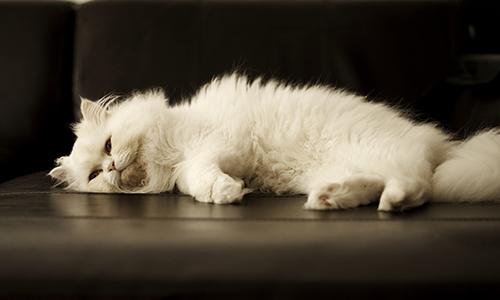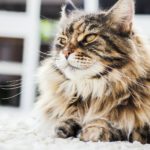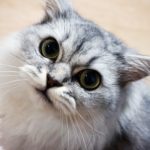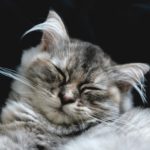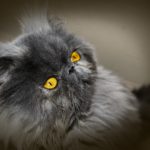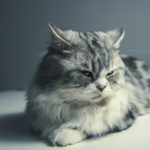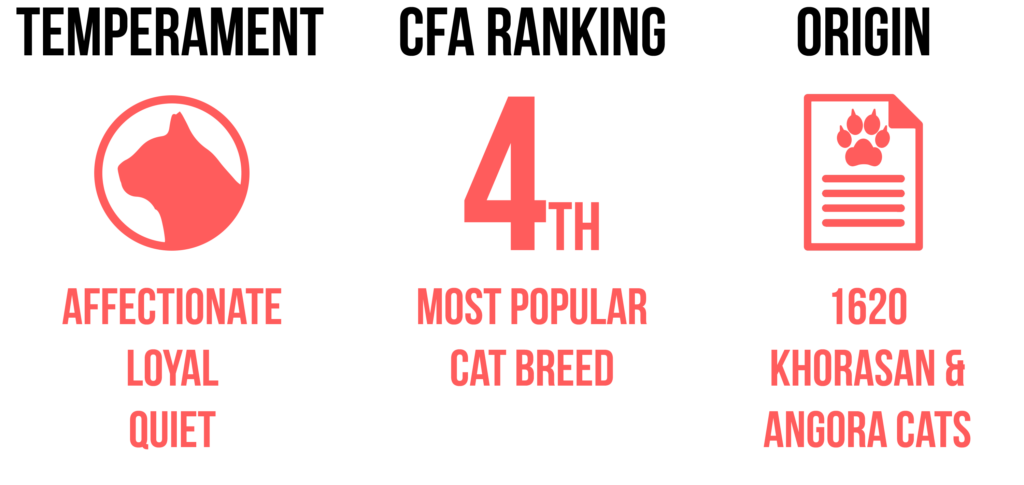
Did You Know?
- Longhair cats like the Persian are rumored to have existed for thousands of years in the Middle East, but some researchers have found that the Persian shares some genetics with cats from Western Europe.
- The origins of the Persian are uncertain. However, one popular theory is that they were brought to Western Europe from Persia (present-day Iran) by Pietro della Valle, a traveling nobleman, after he spotted them at a bazaar and took a liking to them.
- In 1871, the world’s first organized cat show took place at the Crystal Palace in London, drawing in more than 20,000 visitors. Persian cats were among the breeds presented and a Persian kitten even won “Best in Show.”
- Persians were brought to the United States sometime after 1895. The Cat Fanciers’ Association (CFA) was established shortly after in 1906 and the Persian breed was among the first breeds to be registered.
- Many famous historical figures have owned and cherished Persians. Florence Nightingale, the founder of modern nursing, owned a large Persian cat named Mr. Bismarck. Marilyn Monroe had a white Persian named Mitsou. Novelist and screenwriter Raymond Chandler even went so far as to read his first drafts to Taki, his black Persian cat.
- Persian cats are surprisingly low maintenance. Their prissy and aloof demeanor might give you the idea that they are high maintenance animals, but they’re actually very friendly and low maintenance.
- When you think of a Persian cat, the first image that pops into your mind is likely a white or silver-haired cat. However, Persians come in various colors and sizes. From orange to grey to calico, from regular sized to toy and teacup sizes, there are Persians for everyone to love.
- Persians are pop culture icons. If you’ve ever seen Purina’s Fancy Feast food, you will notice a white Persian serving as the mascot for the product. Persians can also be found in James Bond movies and Austin Powers movies. In the films, you will find that each main antagonist (Ernst Stavro Blofield and Dr. Evil, respectively) loves to stroke their white, blue-eyed Persian cat. Persian is also the name given to a species of feline Pokemon.
- One of the more distinctive characteristics in Persians is their flat face. Persians haven’ always had this look; the appearance is a result of a genetic mutation that happened in the 1950’s. Breeders liked this look and continued to develop it. This look is considered the modern breed standard for the breed by the Cat Fanciers’ Association (CFA). However, cats with this look often suffer from labored breathing, runny eyes, and have difficulty eating.
- Persians look very similar to Turkish Angoras. Both breeds came to Europe from the Mediterranean around the 1500’s. In order to improve the Persian, breeders cross-bred them with Turkish Angoras for years to the point that Turkish Angoras almost went extinct.
- A late 19th century oil portrait called My Wife’s Lovers was reportedly sold for $826,000 in 2015. The painting is rumored to be the world’s largest cat painting, depicting a group of Turkish Angoras and Persians owned by the patron. Persians live on in other works of art, such as Two White Persian Cats Looking into a Goldfish Bowl by Arthur Heyer and White Persian Cat by popular folk artist Warren Kimble.
Breed Characteristics
All-Around Friendliness

Family Friendly: 5/5
Kid Friendly: 2/5
Pet Friendly: 2/5
Health & Grooming

Shedding Level: 4/5
Ease of Grooming: 5/5
Average Health: 3/5
Trainability

Intelligence Level: 3/5
Vocalizing Tendencies: 1/5
Playfulness Level: 2/5
Overview
Known as one of the most popular cat breeds around, the Persian (also known as the Persian Longhair) is notable for its beautiful coat and unique head. The Persian has a kind and easy-going disposition, a personality that has hardly changed over the years. However, its overall appearance has changed quite a bit over time.
The modern Persian has big, round, expressive eyes which fit its head perfectly. It has tiny cat ears when compared to their broad, round skulls. Persians have “ear furnishings,” which is what tufted ears are called. Their big, round paws are also tufted with fur. Overall, Persians are medium to large in size. They have stocky bodies and stocky legs, with their massive rumps creating a distinctively stout profile.
Over time, the Persian’s head and facial features have become exaggerated. They are known for their flat-faces, extremely short muzzle, and perky up-turned nose. They have a thick, short neck and a mane-like ruff around it. Persians also have short and bushy tails. Their coat is extremely long and silky, with a thick, soft undercoat to go with it.
Daily grooming is essential to prevent any matting and tangling. Persians shed year-round and should be bathed on a regular basis as well as brushed and groom. To protect them from parasites and outdoor dangers, as well as maintaining their coats, it’s important to keep them exclusively as indoor cats.
History
Persian cats hail from the old lands of Mesopotamia, which eventually became Persia and is known today as Iran. It is believed that in 1626, nobleman and world traveler Pietro della Valle found some Persian cats at a bazaar and brought them to Europe. Persians at the time had silky, shiny grey fur. Due to selective breeding, the modern day Persian comes in a variety of colors.
Longhaired cats like the Persian and the Turkish Angora were usually bred together as far as the late 19th century and were labeled as “Asiatic” cats along with other longhairs from the Mediterranean. Queen Victoria had a fondness for the Persian breed, which helped them become one of the more desirable and popular breeds of its time.
Breeders began to mold the Persian’s appearance to their liking, which is how we have the modern-day Persian cat. Round heads, flat faces, chubby cheeks, big cat eyes, small and round cat ears, and a snub nose are some of the traits present Persians have due to selective breeding. Their legs were made to be shorter than an Angora’s and their fur longer. Soon enough, Persians became even more popular than Turkish Angoras.
Persians continued to be popular across the globe as they made their way into the United States. The Maine Coon cat was known as one of America’s sweethearts when it came to cats, but Persians soon overtook them as well in terms of popularity. Today, the Persian is still one of the most popular cat breeds around the world, known for its beauty and gentle personality.
Size
 Persians are generally medium-sized cats that weigh between 7 and 12 pounds. They also exist in smaller varieties, such as toy size and teacup size.
Persians are generally medium-sized cats that weigh between 7 and 12 pounds. They also exist in smaller varieties, such as toy size and teacup size.
Appearance
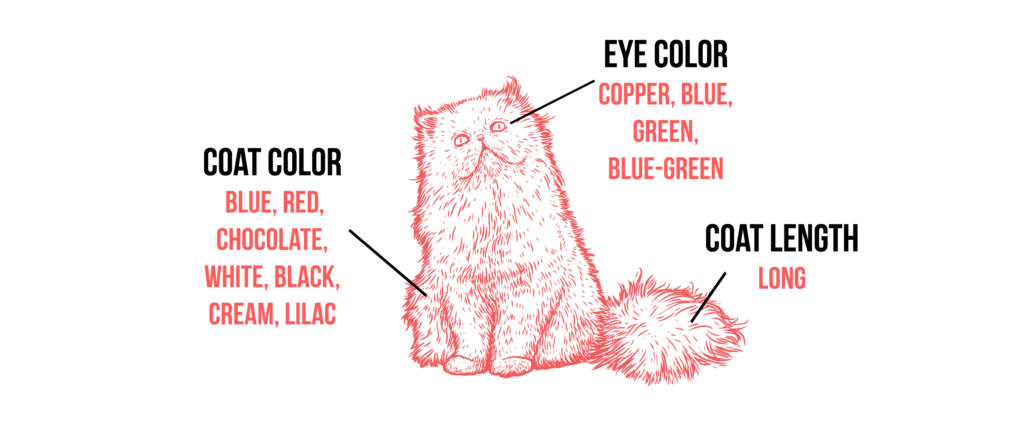 Persian cats have short tails that are proportional to the length of their bodies. They have round, firm paws and short, strong legs. Their head is large and round with big eyes, small ears, and a short nose. They have a thick neck supporting their head and a surprisingly muscular body.
Persian cats have short tails that are proportional to the length of their bodies. They have round, firm paws and short, strong legs. Their head is large and round with big eyes, small ears, and a short nose. They have a thick neck supporting their head and a surprisingly muscular body.
Covering their body is a thick, long, and shiny coat. They have a fluffy ruff around their necks, with long ear and toe tufts, a full tail, and a deep frill between their legs.
Even though the flat-face look is the breed standard for the modern Persian (known as Peke-face Persians), it is not the only look Persians show. There is the “Doll-face” look, which is closer to how Persians used to look, with a more pronounced face than Peke-face and show Persians.
The white-coated Persian is very popular. However, these beautiful cats come in a variety of coat colors and patterns. The list of colors is long: blue, red, chocolate, white, black, cream, lilac, golden, silver, smoke, calico, shaded, tabby, etc.
A Persian’s eye color is directly related to their coat color. For example, gold and silver Persians carry green and blue-green eyes, white Persians have brilliant copper and deep blue eyes, and other solid-colored Persians have the brilliant copper eyes as well.
Behavior
Personality
Persians are quiet and dignified animals who love to be petted and take their rightful place in their family’s lap. As affectionate as they are, they do not just give their love to anybody. Persians must know they can trust you and will be loving towards their family and the few others that manage to have a good rapport with them.
If you have a loud and rambunctious home, then maybe a Persian is not for you. They love calm and tranquil homes. They also love their routines and hate change. Persians are not known for vocalizing a lot, making them great apartment pets, but they will let out a soft, even pleasant yowl when they need something such as food, playtime, or just some affection from their family.
While other cats may willingly climb up your furniture until they reach the highest place available, Persians prefer to stay grounded. If they do jump on furniture, it will be on beds or sofas, not curtains. Your Persian will happily accept any attention you give him as long as you don’t play rough with him.
Children and Other Pets
Persians are loving animals, but they also value their relaxation time. If your children or other pets want to be affectionate towards your Persian, he will be more than happy to receive the attention. However, any type of rough playing or chasing attempts will make them anxious. Teach your pets and children not to disturb your Persian, but that they’re welcome to pet him and hug him.
Health
 Persians are wonderful and kind cats, but unfortunately, they suffer from a number of genetic conditions. If you want to own one, be prepared to visit the veterinarian on a regular basis. These are a few of the conditions that might affect your Persian, most relating to their facial structures:
Persians are wonderful and kind cats, but unfortunately, they suffer from a number of genetic conditions. If you want to own one, be prepared to visit the veterinarian on a regular basis. These are a few of the conditions that might affect your Persian, most relating to their facial structures:
- Ringworm (a fungal infection)
- Heat Sensitivity
- Excessive Tearing
- Difficulty breathing due to constricted nostrils
- Seborrhea Oleosa, a skin condition involving redness, itchiness, and hair loss
- Polycystic Kidney Disease (PKD)
- Cherry Eye
- Entropion
- Dental Malocclusions
Maintenance
Care
Keep the litter box clean at all times, as well as your Persian’s paws. Pieces of litter may become lodge in their paws, so check them during your grooming sessions. If the litter box is dirty, chances are your Persian will stop using it.
You’d be taking a risk if you kept your Persian as an outdoor cat. Persians are lovers, not fighters, and would not do well in street fight with other animals. Time outside also means more time grooming them as their coats would get messy with leaves and dirt. Since they are popular cats, the chances are high of someone stealing them if they’re just left outside, so it’s best to keep them indoors at all times unless supervised.
Feeding
When buying cat food for your Persian, keep in mind the number of vitamins and minerals it contains, as Persians tend to be more sensitive than other cats when it comes to food.
Persians are not vegetarians. Due to their nature, they need to eat meat proteins, so don’t plan on getting a Persian if you want an all-veggie household. Generally, it doesn’t matter if it’s wet or dry food, as long as it contains the necessary nutrients.
It’s important to not overfeed your kitten. Habits form from a young age, so make sure you always measure the amount of food your kitten is eating so they don’t become overweight and suffer from health conditions related to it. For the first year, it’s a good idea to serve your kitten a maximum of one ounce per pound of body weight. After that, change the amount to 0.8-0.9 ounces per pound.
Grooming
To keep your Persian’s coat looking shiny and glamorous, you must upkeep it daily. Gently brush it and comb it every day. Use stainless steel combs to remove any tangles, mats and loose hair as they can become painful if left alone.
The Persian can have a soft, silky coat. Cats with these types of coats tend to matt and tangle more easily, so take special care when grooming them.
Give your Persian a bath at least once a month and blow the coat dry as you comb it. Make sure it’s in the lowest heat setting so you can avoid burning your cat.
To avoid periodontal disease, brush your Persian’s teeth daily – or, at the very least, weekly. Wipe the corners of your Persian’s eyes daily as they tend to suffer from excessive tearing.
Questions
Can we give milk to Persian cats?
When kittens are being weaned, milk is good for them. However, as they grow older, the lactase they use to digest milk disappears from their gut. Adult cats are essentially lactose intolerant, and drinking milk (especially from cows) will give them an upset stomach. If you’re still interested in giving your cat milk, shop around for cat-friendly milk options and double check with your vet.
How much are Persian cats?
Persians can be bought from breeders for as low as $500 to $700 each. However, these Persians will have a limited color palette – for example, blacks or blues. If you’re interested in Persian cats with more coat color options, such as tabby, lilac, shaded silver, or golden, they can be found at a higher cost. The more coat color options, the more each cat will cost.
Do Persian cats shed a lot?
Persians tend to shed year-round, and twice a year they will “blow their coat.”
Have any Persians won the title of Grand Champion/Grand Premiere?
Yes. Click here to visit The Cat Fanciers’ Association (CFA) photo gallery of past Persian grand champions.
Resources
Shelters
If you’re looking to adopt or foster a Persian cat, please check out the following list to find rescue groups, shelters, and organizations that have Persian available for adoption.
Breed Organizations
Below are breed clubs, organizations, and associations where you can find additional information about the Persian cat.
Top Breeders
The following is a list of reputable Persian breeders.
- Persian Babys
- Shadow Oak Persians
- Sejumay Himalayans & Persians
- Di’Rose Cattery
- Last Call Cattery
- Carriecats
- Shoshoni Cattery
- Dja Vu Purrs Cattery
- Show Felines
- Jewells Persians
Persian Cats For Sale
If you’re interested in purchasing an adult cat, click on the links below to find a Persian cattery or a Persian cat breeder that has adult Persians for sale.
Persian Kittens For Sale
Looking for a Persian kitten for sale? If you’re interested in purchasing Persian kittens or Teacup Persians, below you will find different online marketplaces that have Persian kittens for sale.
